One of the biggest challenges facing retailers looking to cut down on shrink due to retail theft and shoplifting is actually knowing what inventory you should have. That seems easy, but it’s challenging because inventory by nature moves.
When an item isn’t on a shelf, it may be in a customer’s cart, or in the back. In some cases, it may have been set aside for curbside pickup or a digital sale.
It’s hard to know what’s missing from your inventory when you don’t track that inventory in real time. If you can do that, you know more or less immediately when something goes missing.
💵💰Don’t miss the move: Subscribe to TheStreet’s free daily newsletter💰💵
In fact, a system could be setup to catch the disparity right away. That may not stop the theft that just happened, but it can identify patterns and help stop future theft.
A number of chains including Academy Sports, Old Navy, and Kroger have been testing RFID technology for inventory tracking. None of the chains say that theft prevention is the key reason, but it’s at worst a happy byproduct.
Walmart and Target, for example, have both been using RFID in their stores but say very little about it. Walmart has a specific policy against talking about its efforts to curb theft.
 Self-checkout has led to increased theft.
Self-checkout has led to increased theft.
Image source: Getty Images
Grocery chains are especially vulnerable
RFID uses small tags on items to allow for real-time inventory tracking. That can be invaluable for real-time inventory management.
If a customer wants to know if an item is in stock, RFID makes that much easier for the chain. It also, in theory, allows the retailer to know when an item has walked out the door without being paid for essentially immediately.
Related: Here’s the horrible way Torrid workers learned about store closures
Kroger (KR) , and any chain the offers self-checkout, is vulnerable to theft. In some cases that theft is accidental as an item may not scan properly.
In many cases, though, thieves use that possibility to not scan items and steal based on the uncertainty of what actually happened.
Kroger is not saying that it’s using RFID to prevent theft, although chains generally do not share what their theft prevention methods are. Instead, it has been testing the technology for another reason.
The chain partnered with Avery Dennison to use its RFID technology and shared the following statement.
More Retail:
- Huge retail chain closing more stores soon (locations revealed)
- Struggling drugstore chain announces second bankruptcy
- Beloved discount grocery chain has massive US plans
“This strategic collaboration will begin in the bakery department, implementing RFID-embedded labels on each item, providing significant time savings and valuable data to automate inventory management and freshness optimization. It is a foundational step in delivering a more seamless customer and associate experience across all fresh categories long term,” according to both companies.
Kroger has maintained that the partnership, as least at its start, is about having products on shelves when customers want them.
RFID has a big retail future
While people seem to only hint around its potential use in theft prevention, RFID use has been growing in retail.
“RFID is one of the genuinely sensible technologies that can make a big difference to a retail business. While it has often been employed in stock control and allowing people to pay quickly (think Uniqlo and Zara self-checkout), it has a lot of other uses in terms of allowing inventory to be tracked, picked, and counted. All of these things improve efficiency and accuracy, and they can be also used to understand how customers shop stores,” retail expert Neil Saunders shared on RetailWire’s comments page.
Jamie Diamond, another RetailWire registered commenter, thinks the impact of RFID will be deep.
“RFID+AI is like peanut butter and jelly and its going to take over the entire supply chain from the moment a product is born to when its purchased and returned and re-sold and recycled – this is knowing everything all the time without scanning anything ever again,” he wrote.
Related: General Mills quietly discontinues three cereals fans loved
While some of the commenters noted that price, although it has been falling, will limit RFID use, most are bullish about its retail applications.
“Item-level RFID adoption is projected to rise in 2025, improving customer experiences, simplifying checkout, and enhancing loss prevention. Retailers can also use RFID for personalized marketing, real-time tracking, and seamless omnichannel integration, boosting efficiency and sales,” added consumer packaged goods expert David Biernbaum.
